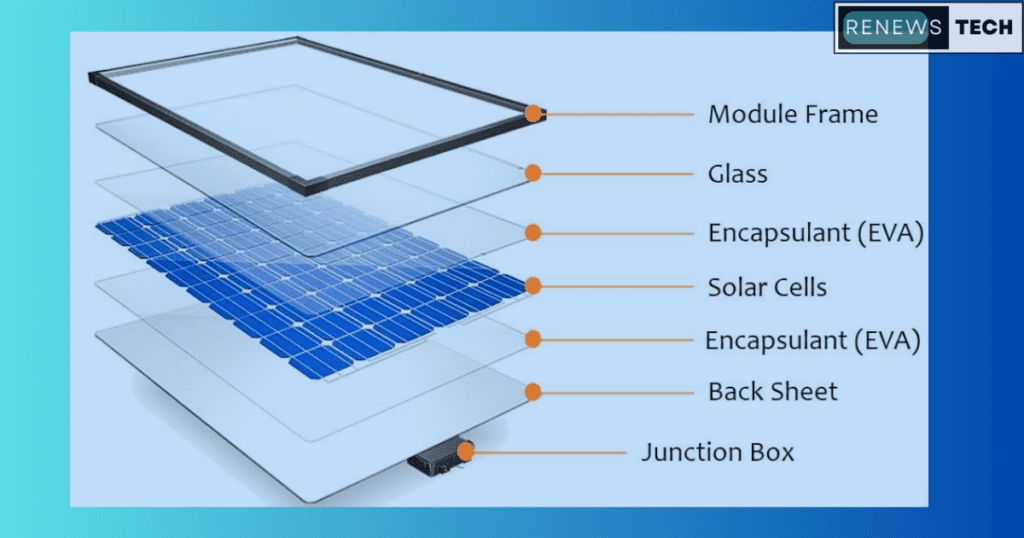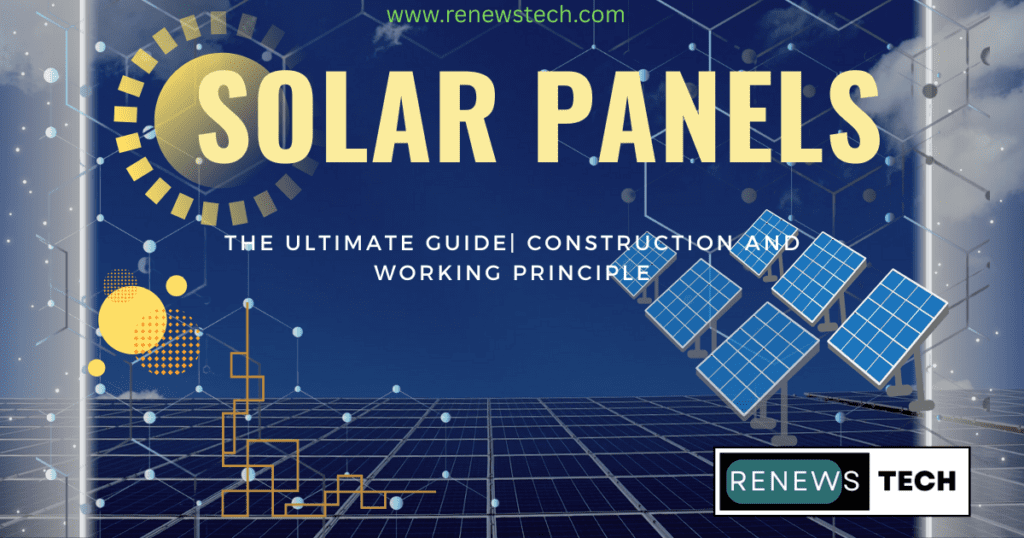Solar Panels: Harnessing The Solar Energy
Introduction
Solar rays can be converted in to electricity with the help of Solar panels. It is like magic, but it’s actually science! Solar energy is one of the most abundant and pollutant free renewable energy sources available. With the rising need for sustainable power, solar panels are becoming a popular choice for homeowners and businesses alike. Let’s dive into their construction and working and understand why they’re a game changer for energy production.
What Are Solar Panels?
Solar panels are devices that converts sunlight into electricity, when solar rays strike on panel, it actually captured by semiconductor and it converts in to the electricity. They are made up of photovoltaic (PV) cells that work together to generate power. You’ve probably seen them on rooftops or in large solar farms.
Construction of Solar Panels


Solar panels consist of multiple layers and components that work together to generate electricity. The key components include:
Photovoltaic (PV) Cells
- PV cell is nothing but the semiconductor diode which converts sunlight in to the electrical energy directly using photovoltaic effect, photons from sunlight excites electrons in semiconductor
- These excited electrons flow through the material and generates an electric current
Glass Cover
- Protects the PV cells from environmental damage.
- Ensures durability and efficiency.
Encapsulation Layers
- Secure the PV cells and prevent moisture penetration.
- Improve the lifespan of the panel.
Back Sheet
- Provides insulation and protects against humidity.
- Helps in maintaining efficiency over time.
Frame
- Usually made of aluminium for strength and easy mounting.
- Provides structural support.
Junction Box
- Contains electrical connections and bypass diodes.
- Ensures safe electricity flow and prevents damage from shading.
Working of Solar Panels
Let’s break it down step by step:
- Sunlight Hits the Panel – The solar cells absorb light and generate electron movement.
- Electric Current Forms – This movement creates a flow of electricity.
- Inverter Converts Energy – The DC electricity is turned into usable AC power.
- Electricity Powers Your Home – The energy runs through your electrical panel and powers your appliances.
- Excess Energy is Stored or Sent to the Grid – If you have batteries, the extra power is stored. If not, it can be sent to the power grid.
Types of Solar Panels
There are different types of solar panels, each with its advantages:
Monocrystalline Solar Panels
- Made from a single crystal of silicon.
- High efficiency and longevity.
- Best for limited roof space.


Polycrystalline Solar Panels
- Made from multiple silicon fragments.
- Slightly less efficient but more affordable.
Thin-Film Solar Panels
- Lightweight and flexible.
- Ideal for large-scale projects.
- Less efficient compared to crystalline panels.
Factors Affecting Solar Panel Efficiency
Several factors influence how well a solar panel performs:
- Sunlight Availability – More sun exposure equals more electricity.
- Panel Orientation and Angle – Proper placement maximizes efficiency.
- Shade and Dirt – Trees or dust can reduce performance.
- Temperature – Extremely high temperatures can lower efficiency.
Benefits of Using Solar Energy
Switching to solar power comes with several perks:
- Saves Money on Electricity Bills – Reduce or even eliminate electricity costs.
- Eco-Friendly – Solar energy is clean and renewable.
- Energy Independence – Less reliance on power companies.
- Higher the Property Value – property with installed solar panels is more attractive to buyers.
Challenges of Solar Energy
While solar power is amazing, there are a few drawbacks:
- Initial Installation Cost – Solar systems require upfront investment.
- Weather Dependency – Less efficient on cloudy or rainy days.
- Space Requirements – Panels need sufficient space for installation.
How to Maintain Solar Panels
Keeping solar panels in top shape is simple:
- Regular Cleaning – Remove dust, leaves, and debris.
- Check for Damage – Inspect panels for cracks or loose connections.
- Monitor Performance – Use solar monitoring systems to track efficiency.
How Long Do Solar Panels Last?
Most solar panels last 25-30 years while maintaining efficiency. Over time, they may lose about 0.5% efficiency per year, but they’ll still generate power for decades.
Solar Energy Storage: Do You Need Batteries?
Batteries store extra power for use during non-sunny hours. They’re ideal if:
- You want backup power during outages.
- You live in areas with limited sunlight.
- You aim for complete energy independence.
Can You Install Solar Panels Yourself?
DIY installation is possible but not recommended unless you have electrical expertise. Professional installation ensures safety, efficiency, and access to warranties.
Government Incentives for Solar Energy
Many governments offer incentives like:
- Tax Credits – Reduce installation costs.
- Rebates – Get cashback on purchases.
- Net Metering – Earn credits for sending power to the grid.
The Future of Solar Energy
With advancements in technology, solar panels are becoming more efficient and affordable. Innovations like solar roof tiles and floating solar farms are pushing the industry forward
![]()
![]()
![]()
![]()
![]()
FAQs
Q1. Do solar panels work during cloudy days?
Yes, but with reduced efficiency. Solar panels still capture diffused sunlight and generate power.
Q2. Can I go completely off-grid with solar panels?
Yes, but you’ll need a battery storage system to maintain power during non-sunny hours.
Q3. What happens if my solar panels generate more electricity than I use?
Excess electricity can be stored in batteries or sent to the grid through net metering, earning you credits on your energy bill.
Q4. Are solar panels recyclable?
Yes, many of the components, like glass, metal, and silicon, can be recycled to create new panels.
Conclusion
Solar panels are a fantastic way to harness the power of the sun and reduce your reliance on traditional electricity sources. They save money, help the environment, and offer energy security. If you’ve ever considered going solar, now is the perfect time to make the switch!







